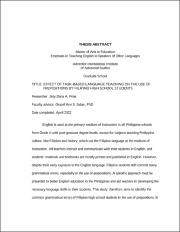| dc.description.abstract | English is used as the primary medium of instruction in all Philippine schools from Grade 4 until post-graduate degree levels, except for subjects teaching Philippine culture, like Filipino and history, which use the Filipino language as the medium of instruction. All teachers instruct and communicate with their students in English, and students’ materials and textbooks are mostly printed and published in English. However, despite their early exposure to the English language, Filipino students still commit many grammatical errors, especially in the use of prepositions. A specific approach must be presented to better English education in the Philippines and aid teachers in developing the necessary language skills in their students. This study, therefore, aims to identify the common grammatical errors of Filipino high school students in the use of prepositions. It
then proposes the task-based language teaching (TBLT) approach to improve the language teaching situation in the Philippines.
The basis of proposing the TBLT approach as an intervention are the following theories: the expansive learning theory introduced by Engostrom (2001), the input hypothesis by Krashen, the output hypothesis by Swain, the interaction hypothesis by Michael Long, and the contrastive analysis hypothesis developed by Robert Lado in 1957 (Kortmann, 2020). The quantitative approach was used, specifically the pre-experimental design with the one-group pretest-posttest design. Nonprobability volunteer sampling was used to gather the participants from four private, faith-based junior high schools located in Region IV-A CALABARZON (Cavite, Laguna, Batangas, Rizal, and Quezon).
The research instrument was a self-constructed TBLT approach activity on the use of the prepositions of location and time, based on a suggested activity by McLoughlin (2016). This activity was administered as the pretest before the participants attended four TBLT classes and then was also administered as the posttest. Lesson plans for the TBLT classes were validated by three experts in the language field prior to implementation.
In conclusion, the results of this study suggest that the TBLT approach is effective in addressing the prepositional errors of Filipino high school students (p = 0.003). No significant difference was found in the students’ posttest scores when considering the moderating variables of gender and school type. Lastly, the most common prepositional errors committed by Filipino high school students are on with prepositions of place and at and in with prepositions of time. It is recommended that a quasi-experimental or true-experimental study be conducted to further validate the results of this study and that a control group or other experimental groups be included for more points of comparison. | en_US |

